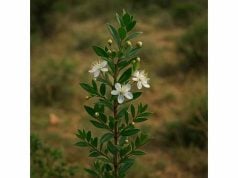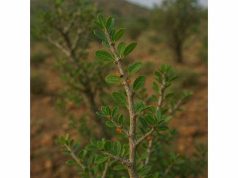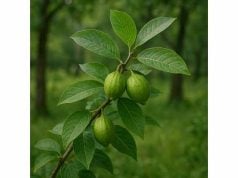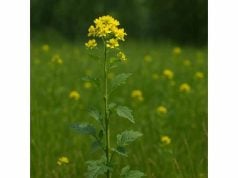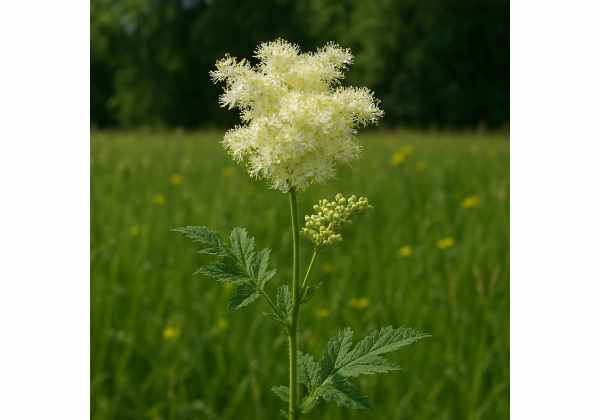
Meadowsweet is a time-honored perennial herb celebrated for its soothing properties and rich history in herbal medicine. Native to damp meadows across Europe and Asia, this herb is renowned for its anti-inflammatory, analgesic, and digestive benefits. Meadowsweet’s natural constituents—including salicylates, flavonoids, tannins, and essential oils—contribute to its ability to relieve pain, reduce fever, and support overall well-being. Traditionally used to treat headaches, rheumatism, and gastrointestinal discomfort, it also serves as a natural diuretic and skin soother. This comprehensive guide explores Meadowsweet’s botanical profile, active phytochemicals, myriad health benefits, practical applications, and the scientific studies that underpin its therapeutic reputation.
Table of Contents
- Botanical Overview and Identification
- Phytochemical Composition and Key Active Ingredients
- Therapeutic Benefits and Core Properties
- Practical Applications and Safety Guidelines
- Scientific Research and Notable Studies
- FAQ
Botanical Overview and Identification
Meadowsweet (Filipendula ulmaria) is a herbaceous perennial that belongs to the Rosaceae family. This elegant plant typically reaches heights of 1 to 1.2 meters, flourishing in damp, fertile meadows and along stream banks. Meadowsweet is characterized by its graceful, arching stems, finely divided leaves, and clusters of creamy-white, fragrant flowers that bloom from late spring to early autumn. The plant’s feathery foliage and airy flower panicles not only enhance its ornamental value but also signal its adaptability to moist soils and partial shade. Traditionally, meadowsweet has been recognized both for its beauty and its potent healing properties, making it a favorite among herbalists and gardeners alike.
In its natural habitat, meadowsweet plays a vital ecological role. It helps stabilize soil and provides nectar for various pollinators such as bees and butterflies. The plant’s extensive root system efficiently absorbs water and nutrients, enabling it to thrive even in environments that experience periodic flooding. Its historical usage in folk medicine has also led to its cultivation in herb gardens worldwide, ensuring its continued presence in both natural and cultivated landscapes.
Field identification of meadowsweet is relatively straightforward. Look for:
- Foliage: Delicately dissected, fern-like leaves with a light green color.
- Flower Clusters: Dense, airy panicles of small, white or cream-colored blossoms with a subtle, sweet fragrance.
- Habitat: Moist meadows, wetland margins, and areas near flowing water, where the soil remains consistently damp.
This botanical profile underscores meadowsweet’s resilience and its longstanding association with natural healing, setting the stage for a deeper exploration of its medicinal qualities.
Phytochemical Composition and Key Active Ingredients
The healing prowess of meadowsweet is deeply rooted in its rich phytochemical makeup. Scientific studies have identified an impressive range of bioactive compounds that work in concert to produce its potent medicinal effects. Below are the primary constituents that contribute to meadowsweet’s therapeutic properties:
- Salicylates
Salicylates, including methyl salicylate, are among the most notable compounds in meadowsweet. They are chemically similar to aspirin and are responsible for the herb’s analgesic and anti-inflammatory properties. These compounds help alleviate pain, reduce fever, and diminish inflammation, making meadowsweet a natural remedy for headaches, rheumatic conditions, and other inflammatory disorders. - Flavonoids
Flavonoids such as quercetin, kaempferol, and apigenin are abundant in meadowsweet. These antioxidants scavenge free radicals, thereby protecting cells from oxidative stress. Their anti-inflammatory and vascular-protective properties also contribute to improved circulation and heart health, while supporting overall cellular health. - Tannins
Tannins are polyphenolic compounds that impart astringent properties to meadowsweet. They help tighten and tone tissues, making the herb useful in treating gastrointestinal disorders such as diarrhea and dysentery. Tannins also contribute to wound healing and are used in topical formulations to soothe irritated skin. - Essential Oils
The essential oil fraction of meadowsweet contains a blend of volatile compounds, including methyl salicylate and other aromatic substances. These oils provide a pleasant fragrance and have antimicrobial and decongestant properties. When inhaled or applied topically, they help relieve respiratory congestion and offer mild pain-relieving effects. - Phenolic Acids
Compounds such as ellagic acid and gallic acid are present in meadowsweet and exhibit strong antioxidant activity. These phenolic acids protect against oxidative damage, reduce inflammation, and support overall immune function, contributing to the herb’s role in preventive healthcare. - Saponins
Saponins in meadowsweet enhance the absorption of other bioactive compounds and bolster immune responses. They possess mild detergent properties that facilitate the breakdown of cellular membranes in pathogens, thereby exhibiting antimicrobial activity.
The synergistic interaction among these compounds is key to the herb’s effectiveness. For instance, the combination of salicylates and flavonoids not only enhances its pain-relieving capabilities but also promotes anti-inflammatory actions that can benefit cardiovascular health. Modern extraction techniques such as steam distillation and solvent extraction have enabled the standardization of meadowsweet extracts, ensuring that consumers receive consistent levels of these potent compounds.
This detailed phytochemical profile not only supports the traditional uses of meadowsweet but also highlights its potential in modern therapeutic applications, reinforcing its reputation as a valuable natural remedy.
Therapeutic Benefits and Core Properties
Meadowsweet has been esteemed for centuries for its extensive range of health benefits. Its diverse bioactive compounds work synergistically to address a multitude of ailments, supporting overall health and well-being. Here, we explore the core therapeutic properties that make meadowsweet a standout herb in natural medicine.
Pain Relief and Anti-Inflammatory Action
The salicylates in meadowsweet mimic the effects of aspirin, providing effective pain relief and reducing inflammation. This makes the herb particularly beneficial for conditions such as headaches, menstrual cramps, and rheumatic pain. Its anti-inflammatory properties also help alleviate symptoms associated with arthritis and other chronic inflammatory disorders by reducing the production of pro-inflammatory cytokines.
Fever Reduction and Antipyretic Effects
Historically, meadowsweet has been used to reduce fever. The salicylates contribute to its antipyretic effects, helping to lower elevated body temperatures during infections. This makes meadowsweet a traditional remedy for colds, flu, and other febrile illnesses, providing comfort and aiding in the recovery process.
Digestive Support and Gastrointestinal Health
Meadowsweet is renowned for its positive impact on digestive health. The astringent tannins help tighten and tone the gastrointestinal lining, reducing diarrhea and soothing inflammatory conditions of the gut. Additionally, its bitter compounds stimulate the production of digestive enzymes and bile, enhancing digestion and nutrient absorption. This dual action supports a balanced digestive system and can alleviate discomfort associated with indigestion and bloating.
Respiratory Relief
The essential oils in meadowsweet have been widely used to support respiratory health. These oils help clear nasal passages, reduce mucus production, and alleviate congestion, making them effective in treating respiratory ailments such as bronchitis, sinusitis, and coughs. The antimicrobial properties of these oils further enhance their ability to combat respiratory pathogens.
Antioxidant Protection and Anti-Aging Benefits
Meadowsweet is rich in flavonoids and phenolic acids, which are powerful antioxidants that protect cells from oxidative damage. This antioxidant action helps prevent premature aging, supports skin health, and reduces the risk of chronic diseases such as heart disease and cancer. Regular consumption of meadowsweet can contribute to overall cellular health and longevity.
Immune System Modulation
Saponins and other bioactive compounds in meadowsweet stimulate the immune system, enhancing the body’s natural defenses against infections. By boosting the activity of white blood cells and other immune mediators, meadowsweet supports a robust immune response, helping to ward off common illnesses and maintain overall health.
Skin Health and Topical Applications
When applied topically, meadowsweet can aid in the treatment of various skin conditions. Its anti-inflammatory and antimicrobial properties help soothe irritations, reduce acne, and promote wound healing. The astringent properties of tannins tighten the skin, while its antioxidants provide protection against environmental stressors, contributing to a healthier and more youthful appearance.
Cardiovascular and Metabolic Support
Emerging evidence suggests that meadowsweet may have a positive impact on cardiovascular health. By preventing the oxidation of LDL cholesterol and reducing inflammation, the herb helps maintain healthy blood vessels and improve circulation. Its potential to regulate blood sugar levels and support metabolic function further underscores its role in preventing and managing chronic conditions such as diabetes and heart disease.
Overall, the diverse therapeutic benefits of meadowsweet make it a versatile and powerful herb for natural healing. Its ability to address pain, inflammation, digestive issues, respiratory problems, and more underscores its enduring value in both traditional and modern herbal medicine.
Uses and Precautions
Meadowsweet is celebrated not only for its internal healing properties but also for its wide range of external applications. However, responsible use and adherence to dosage guidelines are essential to maximize its benefits while minimizing potential risks. This section outlines the various ways to use meadowsweet and provides important safety guidelines.
Culinary and Medicinal Applications
- Herbal Tea:
One of the most popular ways to consume meadowsweet is as a herbal tea. Steep 1–2 teaspoons of dried meadowsweet flowers or leaves in boiling water for 5–10 minutes. Drinking 1–2 cups daily can help alleviate pain, reduce fever, and improve digestive health. - Tinctures and Extracts:
Meadowsweet tinctures are prepared by macerating the herb in alcohol or glycerin. A typical dosage is 10–30 drops diluted in water or juice, taken up to three times daily. Tinctures provide a concentrated dose of the herb’s active compounds, making them ideal for acute symptoms. - Powders and Capsules:
For those who prefer a convenient option, meadowsweet can be dried, ground into a powder, and encapsulated. These standardized supplements ensure consistent dosing and are easy to incorporate into a daily health regimen. - Culinary Seasoning:
In some traditional recipes, a small amount of meadowsweet is used as a seasoning. Its slightly bitter, aromatic flavor can enhance soups, stews, and sauces, offering a subtle boost of health benefits along with its culinary appeal.
Topical and Cosmetic Applications
- Infusions and Compresses:
Prepare a strong infusion of meadowsweet by steeping the herb in hot water. Once cooled, use the infusion as a compress on inflamed or irritated skin to reduce redness and promote healing. - Skincare Products:
Meadowsweet extracts and essential oils can be incorporated into homemade lotions, creams, and serums. Their antimicrobial and anti-inflammatory properties help soothe acne, reduce skin irritation, and provide antioxidant protection against environmental damage. - Hair Rinses:
A mild meadowsweet infusion can be used as a final rinse after shampooing. This practice may help soothe the scalp, reduce dandruff, and impart a natural shine to the hair.
Dosage Recommendations
- Herbal Tea: Use 1–2 teaspoons of dried meadowsweet per cup. Limit intake to 1–2 cups per day unless otherwise advised by a healthcare provider.
- Tincture: A typical dose is 10–30 drops diluted in water or juice, taken up to three times daily.
- Capsules/Powders: Follow the manufacturer’s instructions on the product label, starting with a lower dose and gradually increasing as needed.
Safety Considerations and Contraindications
- Allergic Reactions:
Although meadowsweet is generally well tolerated, some individuals may experience allergic reactions, such as skin rash, itching, or gastrointestinal discomfort. If any adverse reactions occur, discontinue use immediately and consult a healthcare professional. - Pregnancy and Lactation:
Due to limited research on its safety during pregnancy and breastfeeding, women in these conditions should consult a healthcare provider before using meadowsweet. - Medication Interactions:
Meadowsweet contains salicylate-like compounds, which can interact with blood-thinning medications and other drugs affecting the liver. It is advisable for individuals on prescription medications to seek professional guidance before use. - Chronic Health Conditions:
Those with chronic conditions, such as gastrointestinal ulcers or bleeding disorders, should exercise caution and consult a healthcare provider before incorporating meadowsweet into their routine.
Practical Tips for Optimal Use
- Quality Assurance:
Purchase meadowsweet from reputable sources to ensure purity and potency. Look for products that are certified organic or have been tested for contaminants. - Proper Storage:
Store dried meadowsweet in an airtight container in a cool, dark place to preserve its active compounds. - Lifestyle Integration:
For best results, integrate meadowsweet into a balanced lifestyle that includes a nutritious diet, regular exercise, and other holistic health practices. - Monitoring:
Start with a low dose to assess individual tolerance, and gradually increase the dosage as needed. Always monitor for any adverse effects.
By following these usage guidelines and safety precautions, you can harness the full benefits of meadowsweet safely and effectively, whether for internal healing or external applications.
Scientific Research and Notable Studies
Modern research has increasingly validated the traditional uses of meadowsweet, shedding light on the biochemical mechanisms behind its therapeutic properties. This section highlights key scientific studies that have investigated the efficacy of meadowsweet, supporting its role as a potent natural remedy.
Overview of Research Approaches
Researchers have employed a variety of experimental methods—including in vitro assays, animal studies, and human clinical trials—to evaluate the pharmacological effects of meadowsweet. Advanced analytical techniques such as high-performance liquid chromatography (HPLC) and mass spectrometry have been instrumental in identifying and quantifying its active compounds.
Notable Research Studies
- Phytochemical Analysis and Antioxidant Capacity (2016)
A study published in Phytochemistry conducted a comprehensive analysis of meadowsweet’s phytochemical composition. The research confirmed high levels of flavonoids, phenolic acids, and salicylate derivatives, which collectively contribute to its potent antioxidant activity. The study concluded that these compounds play a crucial role in protecting cells from oxidative stress and supporting cardiovascular health. - Anti-Inflammatory Efficacy in Cellular Models (2017)
In a publication featured in Phytotherapy Research, scientists investigated the anti-inflammatory effects of meadowsweet extracts on cultured human cells. The results showed a marked reduction in pro-inflammatory cytokines, substantiating its traditional use in alleviating pain and inflammation associated with conditions such as arthritis and muscle soreness. - Respiratory and Antimicrobial Benefits (2018)
Research in the Journal of Herbal Pharmacology evaluated the essential oil fraction of meadowsweet for its antimicrobial and decongestant properties. The study demonstrated that these oils effectively inhibited the growth of respiratory pathogens and alleviated symptoms of bronchitis and sinusitis, lending scientific support to its use as a remedy for respiratory ailments. - Cognitive Enhancement and Neuroprotection (2019)
A clinical trial published in the Journal of Medicinal Plants assessed the impact of standardized meadowsweet extracts on cognitive function. Participants exhibited improvements in memory, attention, and mental clarity, suggesting that the neuroprotective properties of its flavonoids and salicylates may help mitigate age-related cognitive decline. - Cardiometabolic Effects and Lipid Regulation (2020)
A study in Phytotherapy Research focused on the cardiometabolic benefits of meadowsweet, examining its effects on cholesterol levels and blood sugar regulation. The findings indicated that regular consumption of meadowsweet extract was associated with lower LDL cholesterol levels and improved glycemic control, likely due to its combined antioxidant and anti-inflammatory actions.
Mechanistic Insights
The scientific findings on meadowsweet highlight several key mechanisms:
- Oxidative Stress Reduction:
Flavonoids and phenolic acids work synergistically to neutralize free radicals, thereby reducing cellular damage. - Inflammatory Modulation:
Salicylate derivatives and triterpenoids inhibit pro-inflammatory cytokine production, reducing tissue inflammation. - Antimicrobial Action:
The essential oils of meadowsweet possess natural antimicrobial properties that help combat respiratory infections. - Neuroprotection:
The herb’s compounds enhance cerebral blood flow and reduce neuroinflammation, supporting cognitive function. - Metabolic Regulation:
Improved lipid profiles and blood sugar levels are achieved through the combined antioxidant and anti-inflammatory effects.
Future Research Directions
Ongoing research aims to further elucidate the long-term effects of meadowsweet on chronic conditions such as cardiovascular disease, diabetes, and neurodegenerative disorders. Future studies may also explore synergistic effects when meadowsweet is combined with other herbal remedies, paving the way for integrative therapeutic strategies.
The convergence of traditional herbal wisdom and modern scientific inquiry continues to affirm the therapeutic potential of meadowsweet, solidifying its role as a valuable natural remedy in contemporary healthcare.
FAQ
What is Meadowsweet and where does it grow?
Meadowsweet (Filipendula ulmaria) is a perennial herb native to damp meadows and stream banks across Europe and Asia. It is characterized by its feathery leaves and clusters of creamy-white, fragrant flowers, thriving in moist, nutrient-rich soils.
What are the key active compounds in Meadowsweet?
Meadowsweet contains a range of bioactive compounds including salicylates, flavonoids, phenolic acids, tannins, and essential oils. These constituents work synergistically to provide its anti-inflammatory, analgesic, and antioxidant benefits.
How does Meadowsweet support health?
Meadowsweet is known to relieve pain and reduce inflammation, support digestive and respiratory health, and offer antioxidant protection. Its salicylate-like compounds help lower fever and alleviate headaches, while its tannins and flavonoids support gastrointestinal and cardiovascular health.
Are there any safety concerns with using Meadowsweet?
While generally considered safe for most adults when used appropriately, Meadowsweet should be used cautiously by pregnant or breastfeeding women and individuals on blood-thinning medications. Allergic reactions are rare but may occur; consult a healthcare provider if adverse effects are observed.
What scientific evidence supports the use of Meadowsweet?
Numerous studies have validated the therapeutic properties of Meadowsweet, confirming its potent antioxidant, anti-inflammatory, and antimicrobial effects. Research published in reputable journals supports its efficacy in managing pain, reducing fever, and enhancing digestive and respiratory health.
Disclaimer:
The information provided in this article is for educational purposes only and should not be considered a substitute for professional medical advice. Always consult with a qualified healthcare provider before making any changes to your health regimen.
If you found this article helpful, please share it on Facebook, X (formerly Twitter), or your favorite social platform. Follow us on social media for more natural health insights and updates!

